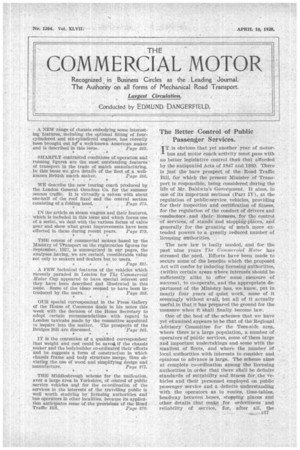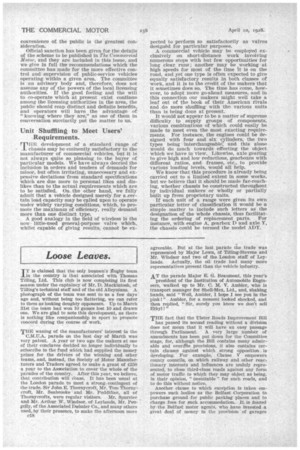The Better Control of Public Passenger Services.
Page 39

Page 40

If you've noticed an error in this article please click here to report it so we can fix it.
IT is obvious that yet another yea]: of motor-Ibus and motor coach activity must Imss with no better legislative control than that afforded by the antiquated Acts • of 1847 and 1889. There is just the bare prospect of the Road Traffic Bill, for which the present Minister of Transport is responsible, being considered 'during the life of Mr. Baldwin's Goveratnent. It aims, in one of its important sections (Part IV), at the regulation of public-service vehicles, providing for their inspection and certification of fitness, for the regulation of the conduct of drivers and conductors and their: licences, for the control -of services, of 'stands and stopping-Places, and .generally for the granting of much more extended powers to a greatly reduced number of licensing authorities. .
The new law is badly needed, and for the past nine years The Commercial Motor has stressed the .need. Efforts have been made to secure some of the benefits which the proposed Act will confer by inducing licensing authorities, (within certain 'areas where interests should be sufficiently alike to offer some measure of success)', to co-operate, and the appropriate department of the Ministry has, we know, put in nearly four years of quiet work, some of it seemingly without avail, but all of it actually useful in that it has prepared the ground for the measure when it shall finally become law.
One of the best of the schemes that we have yet examined aPpears to be that of the Regional Advisory Committee for the Tees-side area, where there is a large population, a number of operators of public services, some of them large and important undertakings and some with the smallest of fleets, and where the number of local authorities with interests to consider and opinions to advance is large. The scheme aims at complete co-ordination among the licensing authorities in order that there shall be definite standards of suitability and fitness for the. vehicles and their personnel employed on public passenger service and a definite understanding . with the operators as to routes., time-tables; headway between-buses, stopping places and other details that Take for orderliness and reliability of service, for, after all, the
convenience of. the public is the greatest consideration.
Official sanction has been given for the details of the scheme to be published in The Commercial Motor, and they are included in this issue, and we give in full the recommendations which the committee has made for the more effective control and supervision of public-service vehicles operating within a given area. The committee is an advisory body and, therefore, does not assume any of the powers of the local licensing authorities. If the good feeling and the will to co-operate which at present exist continue among the licensing authorities in the area, the public should reap distinct and definite benefits, and operators will have the advantage of "knowing where they are," as one of them in conversation succinctly put the matter to us.
Unit Shuffling to Meet Users' Requirements.
THE development of a standard range of chassis may be eminently satisfactory to the manufacturer of commercial vehicles, but it is not always quite so pleasing to the buyer of particular models. We have always decried the inclusion in orders and tenders of demands for minor, but often irritatirip:4 unnecessary and expensive deviations from standard specifications which are due more to personal likes and dislikes than to the actual requirements which are to be satisfied. On the other hand, we fully 'admit that a vehicle designed merely for a sectam n load capacity may be called upon to operate under widely varying conditions, which, to promote the maximum of efficiency, really demand more than one distinct type.
A good analogy in the field of wireless is the now little-used general-purpose valve which, whilst capable of giving results, cannot be ex
pected to perform so satisfactorily as valves designed for particular purposes.
A commercial vehicle may be employed exclusively on short-distance work involving numerous stops with but few opportunities for long clear runs; another may be working at high speeds for most of the time It is on the road, and .yet one type is often expected to give equally satisfactory results in both classes of work, and it is to the credit of the makers that it scknetimes does so. The time has come, however, to adopt more go-ahead measures, and in this connection our makers might well take a leaf out of the book of their American rivals and .do more shuffling with the various units than is being done at present.
It would not appear to be a matter of supreme difficulty to supply groups of components, various combinations of which could easily be made to meet even the most exacting requirements. For instance, the engines could be designed with four and six cylinders, the two types being interchangeable, and this alone would do much towards effecting the object which we have ltt view. Likewise, axle gearing to give high and low reductions, gearboxes with different ratios, and frames, etc., to provide various loading levels, would all help. .
We know that this procedure is already being carried out to a Limited extent in some works, but we believe that it should be made far-reaching, whether chassis be constructed throughout by individual makers or wholly or partially built up from proprietary units. If each unit of a range were given its own particular letter of classification it would be a simple matter to include such letters as the designation of the whole chassis, thus facilitating the ordering of replacement parts. For instance, with engine A, gearbox D and axle Y, the chassis could be termed the model ADY.












































































































